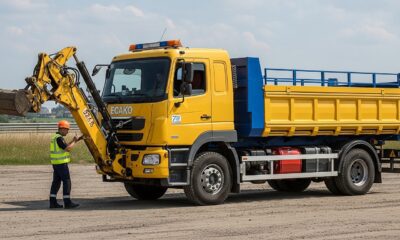

Economy
Working Towards a Restorative Future Now
As Liz Goodwin, chief executive at WRAP said at the Resource event in London recently, there is still too much talk and not enough action to bring about the circular economy. Despite it being dubbed the business model best suited to equip future generations to deal with the planet’s resources, we need to be delivering circular methods on the ground.
It’s not good enough to simply pledge support and take a box ticking approach, it must be reflected in the way an organisation works, especially when their activity is highly dependent on limited earth’s resources. By continuously re-using waste, a better use of resources will come to light, which takes the pressure off what are becoming increasingly scarce materials. To put it simply, we can’t continue to just recycle, we must be reusing products, mining them for their raw matierials and pioneering innovative methods and processes to remanufacture them back into the system.
The problem we’re now facing is that it’s still the minority leading the majority. The London Waste and Recycling Board (LWARB), for instance, is taking big strides towards a restorative future with the introduction of a new initiative within the cities of Amsterdam, Copenhagen and London. The project will see the organisation work with city leaders to pioneer processes, designed to curb waste levels and enhance resource security which could ultimately lead to more efficient working practices in three leading European cities.
Another example of those doing it right is Argos’ with its gadget trade-in scheme. Launched last year, the initiative was rolled out across the UK, enabling customers to conveniently recycle their old devices. Equally, Bandvulc, which provides support tyre management and support services to a fleet of vans using its own retreaded tyres, is an example of a small enterprise thinking on a circular level. In the first three years alone, the restorative business model generated new revenue in excess of £4 million, while providing significant environmental savings, conserving finite raw materials and reducing carbon emissions.
All examples of solid thinking across varying sizes of business, but no seismic shift in directive or approach. So, whilst raising awareness across the entire supply chain is imperative, what exactly should organisations do to ensure they play their part to achieve the global goal of becoming completely restorative?
Simply put, ‘waste’ should not exist. Working with this mentality means that when a product reaches the end of what’s considered it’s ‘useful’ lifecycle, it goes on to create something new and therefore becomes a raw material re-entering the supply chain. While this has obvious environmental benefits, it also has significant cost savings for organisations, not to mention adding to business continuity by decoupling growth from the reliance on limited resources.
Taking a step back
Before considering circular methods, organisations must first take a step back and ensure all the necessary measures are taken to eliminate waste at all stages of a product’s lifecycle.
From how materials are sourced and extracted, to the method of manufacture, performance in use and what happens to it at the end, are all stages that should be considered and evaluated.
Establishing a circular model
Instead of simply discarding it as waste, we must mine a product for its raw material and remanufacture it back into the supply chain. By making the most of surplus material, businesses leaders can not only reduce their own waste to landfill, but also achieve long-term sustainability.
Dutch company Rotterzwam has an interesting take on waste, using coffee bean surpluses reusing it as fertiliser to grow mushrooms.
Supply chain consideration
Waste is all around us, across all sectors and supply chains. An over-engineered product, for instance, is more likely to produce a higher amount of waste during production, not just after it’s served its purpose, which is something that needs to be addressed.
By thinking beyond individual business models and considering how the entire supply chain is functioning, businesses can work together to establish an entirely circular economy. After all, the real shift will only come when all partners, suppliers, stakeholders and customers all make the necessary changes together.
What’s clear is that there is increasing pressure on businesses to ensure they are sourcing like-minded partners that not only help to achieve circular goals, but also work towards establishing manufacturing methods that transform waste into a viable raw material for future products.
Additional benefits
But it’s not simply about the environmental benefits, pioneering a circular model has a list of socio-economic benefits, such as job and income generation for poor communities.
The Net-Works initiative for example, saw Interface team up with the Zoological Society of London (ZSL) to tackle the growing problem of discarded fishing nets in some of the world’s poorest coastal communities, while also providing local villagers and fishermen with supplemental income.
The two organisations co-collaborated to pioneer their own supply chain, together with local residents to source new raw materials from the waste that was polluting their oceans. After establishing a successful community-based supply chain, Interface and ZSL remanufacture the discarded nets into carpet tiles, cleaning up the area’s oceans in the process.
While Net-Works™ demonstrates an innovative model for closing the manufacturing loop; it also provides a template for the future of sustainable manufacturing in the carpet tile industry and beyond.
A future focused lens
Business leaders must think laterally by assessing the applications for ‘waste’ materials, which can be transformed and open the door to unlimited revenue stream and innovation opportunities.
By focusing on improving the way products are sourced, manufactured, consumed and disposed, change will happen. Organisations must work together to strive for a common goal. After all, the future should not only be sustainable, but also as restorative and economically viable.
This article is attributed to Ramon Arratia, Sustainability Director at Interface


 Environment10 months ago
Environment10 months agoAre Polymer Banknotes: an Eco-Friendly Trend or a Groundswell?

 Environment11 months ago
Environment11 months agoEco-Friendly Home Improvements: Top 7 Upgrades for 2025

 Features9 months ago
Features9 months agoEco-Friendly Cryptocurrencies: Sustainable Investment Choices

 Features10 months ago
Features10 months agoEco-Friendly Crypto Traders Must Find the Right Exchange



























